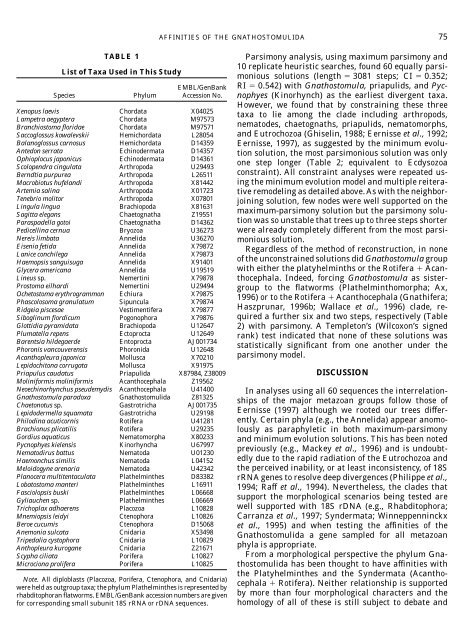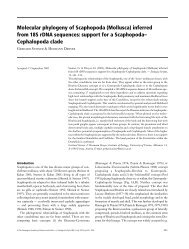Gnathostomulida—An Enigmatic Metazoan Phylum from both ...
Gnathostomulida—An Enigmatic Metazoan Phylum from both ...
Gnathostomulida—An Enigmatic Metazoan Phylum from both ...
You also want an ePaper? Increase the reach of your titles
YUMPU automatically turns print PDFs into web optimized ePapers that Google loves.
TABLE 1<br />
List of Taxa Used in This Study<br />
Species <strong>Phylum</strong><br />
EMBL/GenBank<br />
Accession No.<br />
Xenopus laevis Chordata X04025<br />
Lampetra aegyptera Chordata M97573<br />
Branchiostoma floridae Chordata M97571<br />
Saccoglossus kowalevskii Hemichordata L28054<br />
Balanoglossus carnosus Hemichordata D14359<br />
Antedon serrata Echinodermata D14357<br />
Ophioplocus japonicus Echinodermata D14361<br />
Scolopendra cingulata Arthropoda U29493<br />
Berndtia purpurea Arthropoda L26511<br />
Macrobiotus hufelandi Arthropoda X81442<br />
Artemia salina Arthropoda X01723<br />
Tenebrio molitor Arthropoda X07801<br />
Lingula lingua Brachiopoda X81631<br />
Sagitta elegans Chaetognatha Z19551<br />
Paraspadella gotoi Chaetognatha D14362<br />
Pedicellina cernua Bryozoa U36273<br />
Nereis limbata Annelida U36270<br />
Eisenia fetida Annelida X79872<br />
Lanice conchilega Annelida X79873<br />
Haemopsis sanguisuga Annelida X91401<br />
Glycera americana Annelida U19519<br />
Lineus sp. Nemertini X79878<br />
Prostoma eilhardi Nemertini U29494<br />
Ochetostoma erythrogrammon Echiura X79875<br />
Phascolosoma granulatum Sipuncula X79874<br />
Ridgeia piscesae Vestimentifera X79877<br />
Siboglinum fiordicum Pogonophora X79876<br />
Glottidia pyramidata Brachiopoda U12647<br />
Plumatella repens Ectoprocta U12649<br />
Barentsia hildegaerde Entoprocta AJ001734<br />
Phoronis vancouverensis Phoronida U12648<br />
Acanthopleura japonica Mollusca X70210<br />
Lepidochitona corrugata Mollusca X91975<br />
Priapulus caudatus Priapulida X87984, Z38009<br />
Moliniformis moliniformis Acanthocephala Z19562<br />
Neoechinorhynchus pseudemydis Acanthocephala U41400<br />
Gnathostomula paradoxa Gnathostomulida Z81325<br />
Chaetonotus sp. Gastrotricha AJ001735<br />
Lepidodermella squamata Gastrotricha U29198<br />
Philodina acuticornis Rotifera U41281<br />
Brachionus plicatilis Rotifera U29235<br />
Gordius aquaticus Nematomorpha X80233<br />
Pycnophyes kielensis Kinorhyncha U67997<br />
Nematodirus battus Nematoda U01230<br />
Haemonchus similis Nematoda L04152<br />
Meloidogyne arenaria Nematoda U42342<br />
Planocera multitentaculata Plathelminthes D83382<br />
Lobatostoma manteri Plathelminthes L16911<br />
Fasciolopsis buski Plathelminthes L06668<br />
Gyliauchen sp. Plathelminthes L06669<br />
Trichoplax adhaerens Placozoa L10828<br />
Mnemiopsis leidyi Ctenophora L10826<br />
Beroe cucumis Ctenophora D15068<br />
Anemonia sulcata Cnidaria X53498<br />
Tripedalia cystophora Cnidaria L10829<br />
Anthopleura kurogane Cnidaria Z21671<br />
Scypha ciliata Porifera L10827<br />
Microciona prolifera Porifera L10825<br />
Note. All diploblasts (Placozoa, Porifera, Ctenophora, and Cnidaria)<br />
were held as outgroup taxa; the phylum Plathelminthes is represented by<br />
rhabditophoran flatworms. EMBL/GenBank accession numbers are given<br />
for corresponding small subunit 18S rRNA or rDNA sequences.<br />
AFFINITIES OF THE GNATHOSTOMULIDA<br />
Parsimony analysis, using maximum parsimony and<br />
10 replicate heuristic searches, found 60 equally parsimonious<br />
solutions (length � 3081 steps; CI � 0.352;<br />
RI � 0.542) with Gnathostomula, priapulids, and Pycnophyes<br />
(Kinorhynch) as the earliest divergent taxa.<br />
However, we found that by constraining these three<br />
taxa to lie among the clade including arthropods,<br />
nematodes, chaetognaths, priapulids, nematomorphs,<br />
and Eutrochozoa (Ghiselin, 1988; Eernisse et al., 1992;<br />
Eernisse, 1997), as suggested by the minimum evolution<br />
solution, the most parsimonious solution was only<br />
one step longer (Table 2; equivalent to Ecdysozoa<br />
constraint). All constraint analyses were repeated using<br />
the minimum evolution model and multiple reiterative<br />
remodeling as detailed above. As with the neighborjoining<br />
solution, few nodes were well supported on the<br />
maximum-parsimony solution but the parsimony solution<br />
was so unstable that trees up to three steps shorter<br />
were already completely different <strong>from</strong> the most parsimonious<br />
solution.<br />
Regardless of the method of reconstruction, in none<br />
of the unconstrained solutions did Gnathostomula group<br />
with either the platyhelminths or the Rotifera � Acanthocephala.<br />
Indeed, forcing Gnathostomula as sistergroup<br />
to the flatworms (Plathelminthomorpha; Ax,<br />
1996) or to the Rotifera � Acanthocephala (Gnathifera;<br />
Haszprunar, 1996b; Wallace et al., 1996) clade, required<br />
a further six and two steps, respectively (Table<br />
2) with parsimony. A Templeton’s (Wilcoxon’s signed<br />
rank) test indicated that none of these solutions was<br />
statistically significant <strong>from</strong> one another under the<br />
parsimony model.<br />
DISCUSSION<br />
In analyses using all 60 sequences the interrelationships<br />
of the major metazoan groups follow those of<br />
Eernisse (1997) although we rooted our trees differently.<br />
Certain phyla (e.g., the Annelida) appear anomolously<br />
as paraphyletic in <strong>both</strong> maximum-parsimony<br />
and minimum evolution solutions. This has been noted<br />
previously (e.g., Mackey et al., 1996) and is undoubtedly<br />
due to the rapid radiation of the Eutrochozoa and<br />
the perceived inability, or at least inconsistency, of 18S<br />
rRNA genes to resolve deep divergences (Philippe et al.,<br />
1994; Raff et al., 1994). Nevertheless, the clades that<br />
support the morphological scenarios being tested are<br />
well supported with 18S rDNA (e.g., Rhabditophora;<br />
Carranza et al., 1997; Syndermata; Winneppenninckx<br />
et al., 1995) and when testing the affinities of the<br />
Gnathostomulida a gene sampled for all metazoan<br />
phyla is appropriate.<br />
From a morphological perspective the phylum Gnathostomulida<br />
has been thought to have affinities with<br />
the Platyhelminthes and the Syndermata (Acanthocephala<br />
� Rotifera). Neither relationship is supported<br />
by more than four morphological characters and the<br />
homology of all of these is still subject to debate and<br />
75








